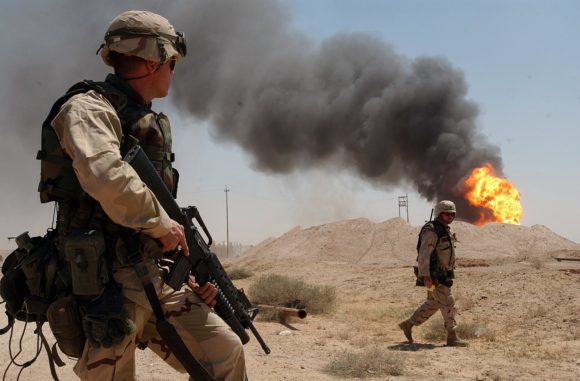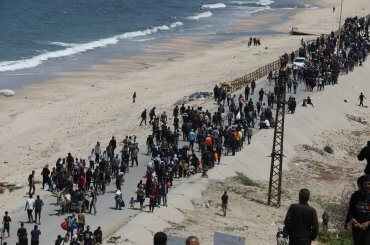OILCRAFT
The Myths of Scarcity and Security That Haunt U.S. Energy Policy
by Robert Vitalis
240 pp Stanford University Press $24
Why is the Arab region and especially the Arabian Gulf the center of US force projection, military bases, and diplomatic intrigue? And what makes the US state and its people so reluctant to rid itself of the millstone of the US-Kingdom of Saudi Arabia relationship?
It is to those questions that Robert Vitalis, a longtime professor at the University of Pennsylvania and a former member of the radical political economy magazine, Middle East Report, turns in his new book, Oilcraft. Vitalis aims to show how false ideas about oil circulate and justify interlocked networks of profit and malfeasance, from pontificating pundits to weapons dealers selling their wares to the Al Saud family.

The idea that “a capitalist class preserves its domination over the globe through increasing projection of military might in the vicinity of the oil fields of the Persian Gulf” is bunk. So is “the left’s unspecified, let alone empirically validated accounts of the project of hegemonic control.”
The book first dispels the intellectual maneuver which Vitalis considers oilcraft, a mental map of the social terrain which explains (away) US brutality in the Arab/Iranian region by claiming it is all about access.
The Al Saud have oil. They have had oil. They profit from selling oil. Therefore they will sell it. Because he considers this essentially how commodity markets work, he believes oilcraft is spun by a set of spinners, above all a self-interested intelligentsia. The web entraps common people, who believe it. Policymakers are in turn trapped by public opinion and the risk of paying “high political costs in being second-guessed by domestic opponents and rivals.” Leaders may not believe these tales – Vitalis implies they do not – but they are “deeply engrained, and leaders find it too risky to do otherwise.”
Vitalis’s trump card is retelling the story of the non-embargo of 1973, when the Arab states barely lowered production. Apocalyptic tales of oil shortage were apocryphal. 1973 saw increases in the posted price of oil, or the price the Arab states used as the basis for taxation. The great “oil price hike” was not a huge supply-shock which forced the US to armor the Persian Gulf to protect “access.” It reflected oil producers’ decision to increase prices so they would return to their long-term gold equivalent after many years of devaluation. The 1970s price increases were less a whoosh upwards and more about treading water.
So what accounts for the US militarization of the Arab region?
First: energy security experts and other thoughtless leaders who have pushed intervention and received good cash for hyping a non-existent threat to “access.”
Second: US development projects, counter-revolutionaries paid for via oil money-funded slush funds, Pentagon-linked assembly lines, foundations, charities, generals, and the federal government deficit which is funded by treasury purchases, often from Gulf sovereign wealth funds.
Now, what to make of all this? On the one hand, Vitalis does well to remind us that we cannot always take the words of the national security bureaucracy or offense intellectuals at face value.
But consider Vitalis’s own evidence. He discusses how because of the US military presence, oil is traded in dollars, strengthening the US foreign exchange position. As a result, the US dollar is the world reserve currency, a phenomenon known as dollar seignoriage. Through this mechanism, the US is able to extract world-wide imperial rents, including from Europe and Japan, who hold important dollar reserves, stabilizing domestic capitalism in the US. And most of the rents from those various accumulation circuits go to the US upper class.
What does Vitalis think capitalist hegemony is, other than the actual history of class struggle within the actual world, including, of course, dollar seignoriage – a phenomenon he acknowledges?
Furthermore, it matters who produces oil and how much, concrete matters that veer closer to an ever-slightly-more-generous understanding of “access.” To control how much oil is produced, one must control who produces it, and under what circumstances. This was extremely well-established with respect to Texas oil in the 1920s and 1930s, when overproduction evaporated producer profits, driving the price into the ground.
Access is a shorthand for controlling who gets to produce and how much.
To take the best example, historically Iraqi oil has been underexplored. Even before Iraq fell out of the imperial orbit with the 1958 revolution, under-exploring its fields, preventing them from becoming “official” reserves was the absolute priority of the Iraqi Petroleum Company (IPC). The 1958 Iraqi revolution and the 1958-1978 Iraqi fight for control over their own national oil company, a story told in Brandon Wolfe-Hunnicut’s forthcoming The Paranoid Style in American Diplomacy, makes clear how a particular political architecture for oil production and extraction – call it access, if you like – has been central.
From 1980-2020, since Iraq got control of its national petroleum industry, it has simply been leveled, through US stoking and arms dealing to each side of the Iran-Iraq War. During that period, and indeed before it, Saudi Arabia and Kuwait, US clients, were allowed to produce freely.
In 1979, the leveling of Iran started when it broke from the US orbit.
In each case, each country began to use the oil wealth available to it to build up popular infrastructure – what the State Department calls “nationalist development.”
Such a policy has been consistent with the broader US policy of absolutely destroying the Arab republics which gave some land to their peasants, which tried to industrialize, and which did not align with US foreign policy. Hence the 1967 US-Israeli war on radical Syria and Nasserist Egypt, the US-Jordanian attack on Marxist Palestinian revolutionaries, US incitement of the Civil War in Lebanon, and more recently, US military devastation of major and minor Arab population centers with any history at all of opposition or non-alignment with the US, from Libya to Syria, Iraq, and Yemen.
In the world we inhabit, not a hypothetical, possible, or different world, the US strategy has been successful, and can be measured in massive accumulation of wealth by the US ruling class, and mounting normalization with Israel by the US clients in the region.
To establish that sovereign, national, independent, and confederated popular development with sovereign industrialization within the Arab region would have been an outcome that could have been injurious to US capitalism is by definition a speculative exercise. It is made yet more speculative the greater the success of the counter-revolution. So we are left to conjecture about the weight of evidence, what we know about the history of US policy based on declassified documents, and to think about why the US would carry out the policies it does now.
But the weight of the evidence is overwhelming that militarization of US policy in the Arab region has assisted US accumulation and prevented Arab popular development, including through the sovereign use of oil monies, and this has been precisely its aim.
Those who, in Vitalis’s words, hope to “reverse the militarization of U.S. foreign policy” will have to work harder than he has to first understand and interpret it accurately.



https://oilprice.com/Latest-Energy-News/World-News/Iran-Significantly-Boosts-Oil-Exports-Despite-Sanctions.html
OilPrice.com
“Iran Significantly Boosts Oil Exports Despite Sanctions”
By Tsvetana Paraskova – Sept. 25, 2020
EXCERPT:
“Iran is estimated to have exported nearly 1.5 million barrels per day (bpd) of crude oil and condensate so far in September, TankerTrackers told Reuters, in what would be the highest level of Iranian exports in a year and a half and double the observed exports in August.”